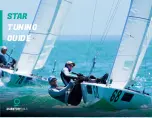
4
.
The shortest straight rod is the keel. The curved parts with metal forks are stems. Place the keel in the canoe. Insert the
narrow end of one stem into the keel rod end. Lift the gunwales and clip the center of the gunwale terminator onto the top of
the stem. Repeat the process with the other stem at the other end of the canoe.
Note: You must have the gunwale terminators in place on top of the stems before proceeding to the next step.
5
.
The two longest remaining rods are chine rods identified by yellow stickers. The ends of the chine rods fit onto the forks
(also marked with yellow stickers) attached to the stems nearest each end of the canoe (the fork prongs fit into the ends of the
rods). With the rod attached at one end, make the rod form an even arc and attach to the corresponding fork at the other end.
Push the center of the rod down and to the side so it rests inside the canoe skin. Repeat the process with the other rod of the
same length. Repeat step 5 with the latch rods identified by the blue sticker fitting onto the forks designated by the blue sticker.
Make sure the latches at the center of the latch rods point in the same direction on both rods. The latches should be on top of
the rod.
Note: When the longitudinal rods are installed, the stems are pushed into the ends of the canoe skin, exposing the
narrow sections that were inserted into the keel. If the joints of the keel rod start separating, pull the keel rod away
from the stems enough to close the keel joints.
6.
Inflate the air tubes loosely by mouth (this gives the right amount of pressure to help assembly).
7.
Lay out the cross ribs next to the canoe with the narrow ones closest to the ends and the widest ones at the center.
Installation will begin with the widest cross rib at the center of the canoe.
8
.
Get into the canoe and position yourself so the open
side of the latches that secure the center cross rib are
towards you and about a foot away. Pick up the widest
cross rib (there are two in the PakCanoe 140, 165 and 170
either will work) and turn it so the open sides of the spacer
clips face the open latches.
See Fig 3.
9
.
Make sure the clips at the ends of the cross rib are in
the unlocked position (see panel on locking sleeve). Place
the cross rib inside and across the canoe between you and
the latches. Tilt the top ends of the cross rib away from
you and insert one end into the opening in the gunwale
channel. Press the end of the cross rib up against the
gunwale so that the C-clip snaps around the gunwale and
holds it. Repeat on the other side of the canoe. Pivot the
bottom part of the cross rib toward the latch until you feel
some tension in the canoe skin. Position the longitudinal
rods in the positions defined by spacer clips on the cross
rib. Pivot the cross rib all the way so the latches snap shut. Secure the latches with the elastic bands that are installed around
the latch rod. Lock the C-clips that connect the cross rib to the gunwales (see panel on locking sleeve).
10
.
Pick up one of the airbag support rods with black plastic end caps and slide it behind the cross rib you installed, in the
groove between the lower air chambers. Center the rod so it reaches equally into both ends of the canoe. The arc in the rod
will
keep it in place between the air chambers during assembly. Repeat the process with the rod on the other side of the canoe.
11
.
The rest of the cross ribs are much easier to install, but the process is the same.
12.
Once all cross ribs are in place, the air tubes can be fully inflated. You can do this by mouth. To use the pump, insert the
tip of a valve into the hose on the pump, turn the tip (and pump) counter-clockwise to open the valve, pump to desired
pressure, close the valve by turning tip clockwise, and remove the pump.
Note: The canoe will work well even if you just inflate the bags as hard as you can by mouth
.
13
.
Install the fabric end caps on the canoe with matching Velcro on end caps and canoe skin.
14
.
Seats are installed with one pair of legs on top of a cross rib and the other pair on a seat support rod. The seat support rod
has a spacer clip at the center to rest on the keel and "C"-clips at the ends. It is bent so that it will connect to the cross rib.
3.
2























